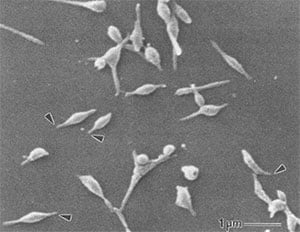CDC reports that Mycoplasma pneumoniae is an “atypical” bacterium (the singular form of bacteria) that commonly causes infections of the respiratory system. The most common type of illness caused by these bacteria, especially in children, is tracheobronchitis, commonly called a chest cold. This illness is often seen with other upper respiratory tract symptoms, like a sore throat. Sometimes M. pneumoniae infection can cause pneumonia, a more serious infection of the lungs, which may require treatment or care in a hospital.
M. pneumoniae infections are sometimes referred to as “walking pneumonia.” Some experts estimate that between 1 and 10 out of every 50 cases of community-acquired pneumonia (lung infections developed outside of a hospital) in the United States is caused by M. pneumoniae. However, not everyone who is exposed to M. pneumoniae develops pneumonia.
In general, M. pneumoniae infection is a mild illness that is most common in young adults and school-aged children. Outbreaks of M. pneumoniae occur mostly in crowded environments, like schools, college dormitories, military barracks, and nursing homes, when small droplets of water that contain the bacteria get into the air by coughing and sneezing while in close contact with others, who then breathe in the bacteria. M. pneumoniae infections often spread within households.
Recent analysis of electron microscope photos of mycoplasma pneumoniae enabled the development of a frequency set for this organism. This was added to related frequencies developed over the past decade to deal with lyme disease. David Scott reported on the likely source of mycoplasma in lyme disease some years ago.
PATHOGENIC MYCOPLASMA
A Common Disease Agent Weaponised
See David Scott. Mycoplasma: The Linking Pathogen in Neurosystemic Diseases. Nexus Magazine, Aug 2001.
There are 200 species of Mycoplasma. Most are innocuous and do no harm; only four or five are pathogenic. Mycoplasma fermentans (incognitus strain) probably comes from the nucleus of the Brucellabacterium. This disease agent is not a bacterium and not a virus; it is a mutated form of the Brucella bacterium, combined with a visna virus, from which the mycoplasma is extracted.
The pathogenic Mycoplasma used to be very innocuous, but biological warfare research conducted between 1942 and the present time has resulted in the creation of more deadly and infectious forms of Mycoplasma. Researchers extracted this mycoplasma from the Brucella bacterium and actually reduced the disease to a crystalline form. They “weaponised” it and tested it on an unsuspecting public in North America.
Dr Maurice Hilleman, chief virologist for the pharmaceutical company Merck Sharp & Dohme, stated that this disease agent is now carried by everybody in North America and possibly most people throughout the world.
Despite reporting flaws, there has clearly been an increased incidence of all the neuro/systemic degenerative diseases since World War II and especially since the 1970s with the arrival of previously unheard-of diseases like chronic fatigue syndrome and AIDS.
According to Dr Shyh-Ching Lo, senior researcher at The Armed Forces Institute of Pathology and one of America’s top mycoplasma researchers, this disease agent causes many illnesses including AIDS, cancer, chronic fatigue syndrome, Crohn’s colitis, Type I diabetes, multiple sclerosis, Parkinson’s disease, Wegener’s disease and collagen-vascular diseases such as rheumatoid arthritis and Alzheimer’s.
Dr Charles Engel, who is with the US National Institutes of Health, Bethesda, Maryland, stated the following at an NIH meeting on February 7, 2000: “I am now of the view that the probable cause of chronic fatigue syndrome and fibromyalgia is the mycoplasma…”
I have all the official documents to prove that mycoplasma is the disease agent in chronic fatigue syndrome/fibromyalgia as well as in AIDS, multiple sclerosis and many other illnesses. Of these, 80% are US or Canadian official government documents, and 20% are articles from peer-reviewed journals such as the Journal of the American Medical Association, New England Journal of Medicine and the Canadian Medical Association Journal. The journal articles and government documents complement each other.
The mycoplasma acts by entering into the individual cells of the body, depending upon your genetic predisposition.
You may develop neurological diseases if the pathogen destroys certain cells in your brain, or you may develop Crohn’s colitis if thepathogen invades and destroys cells in the lower bowel.
Once the mycoplasma gets into the cell, it can lie there doing nothing sometimes for 10, 20 or 30 years, but if a trauma occurs like an accident or a vaccination that doesn’t take, the mycoplasma can become triggered.
Because it is only the DNA particle of the bacterium, it doesn’t have any organelles to process its own nutrients, so it grows by uptaking pre-formed sterols from its host cell and it literally kills the cell; the cell ruptures and what is left gets dumped into the bloodstream.
